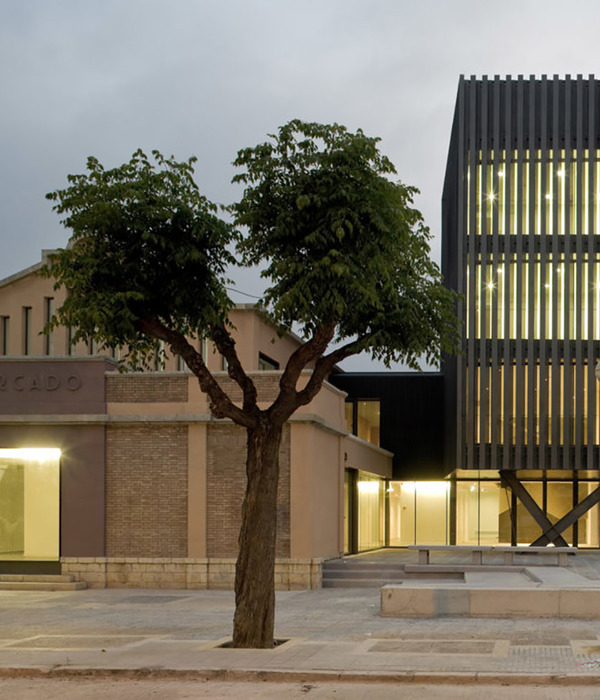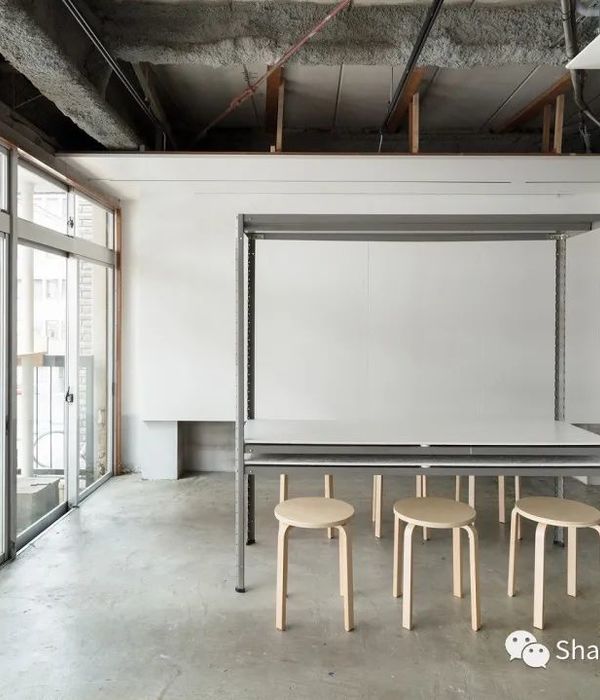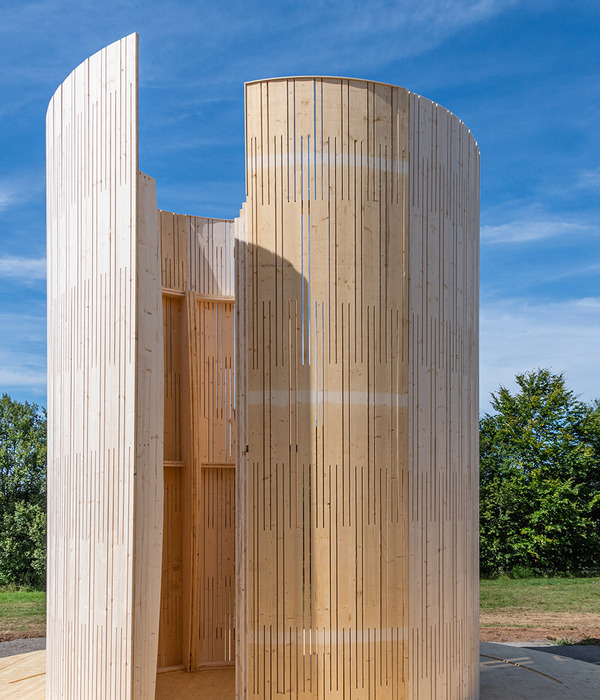越南“未来废墟”办公楼 | 混凝土网格与自然共生
这座建筑以神秘的姿态从地面生长出来,混凝土立柱有节奏地延伸至4个楼层,并在中间围合出一个庭院。柔和的夕阳照亮了混凝土骨架,使其与天际线融为一体。
Growing mysteriously from the ground, concrete columns move rhythmically, branching and wrapping four levels of the courtyard building. Concrete Lace is illuminated by the soft golden light of the setting sun, becoming a part of the skyline. Evening light shines through, interweaving between the concrete skeleton and the skyline.
▼建筑外观,exterior view

这座独特的建筑是高科技园区总规划Village 3的一部分。户外庭院的设计以越南北部传统的乡村为灵感,连接了4条不同的路径,一方面与葱郁的室外景观相连,另一方面则提供了四个有着传统乡村氛围的主要入口。
This curious building is part of Village 3 in the High-Tech Park master plan. Inspired by local, traditional North Vietnamese village features, the exposed courtyard radiates four pathways; connecting to the lush external landscape and acting as four entrances that reminisce the main gates of a traditional village.
▼户外庭院视角,view from the courtyard

12×25米的网格结构为灵活且高效的空间提供了可能。绿化区和开放空间相互穿插,优化了使用者的体验,使其能够充分地与自然景观形成互动、放松身心。可持续设计贯穿了整个建筑,主要体现为自然光的最大化利用、自然通风、办公室内部花园、空中花园、雨水循环系统以及当地环保材料的使用等。
The grid structure of 12×25 meters allows a highly flexible and efficient use of space. Mixing green areas and open spaces they enhance the user’s experience through the building; inviting them to exchange, relax and enjoy the landscape. Sustainable design is ubiquitous; through maximising natural light, natural ventilation, gardens inside offices, sky gardens, rain water recycling and the use of local eco-friendly materials.
▼富有韵律感的混凝土网格,the concrete columns move rhythmically
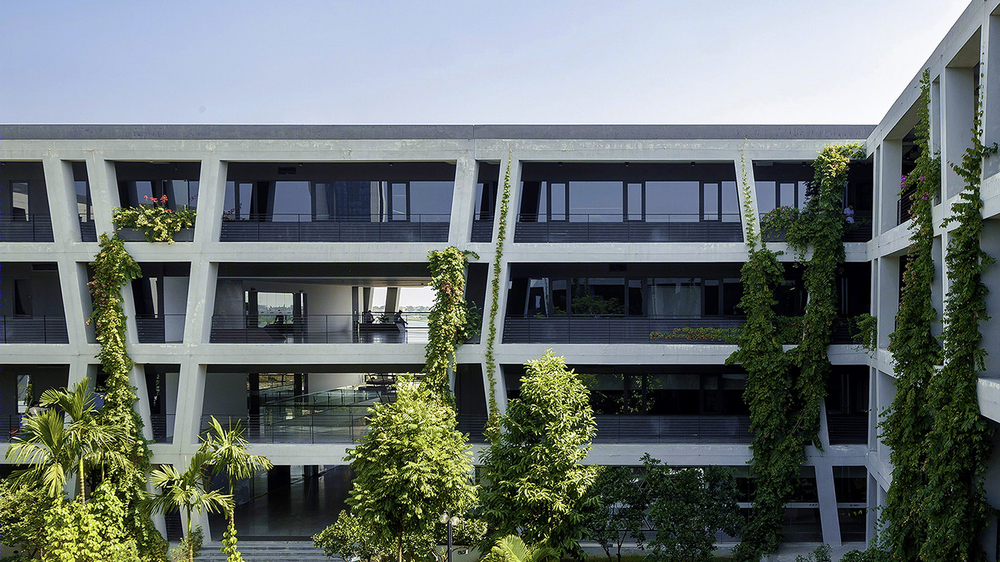
▼从公共空间望向户外庭院,view to the courtyard from the public area

▼立面细部,facade view

建筑的外壳是一个关键的可持续元素,它将攀爬植物结合在立面上,使其成为一道天然的遮阳屏幕。植物的密度和厚度根据不同的朝向和日晒量进行了精心调整。这些元素共同构成了一个动态的、与自然环境紧密结合的绿色建筑。
The external layer acts as a key sustainable element of the building. It integrates climbing trees, acting as green protection against the sun, its density and thickness has been carefully adapted from different orientations and facade exposure. Together these elements create a dynamic green building that is integrated in nature and connected with its environment.
▼攀爬植物结合在立面上,climbing trees are integrated with the external layer

一座建筑在处于“废墟”状态时,往往会被忽略和弃置。这种认为建筑过了“有效日期”的观念已经不能适应当下的可持续观念。在该项目中,“可持续的废墟”形成了一种独特的美学,它与建筑本身的生命周期形成了融合,使其能够继续适应未来的使用需要。G8A事务所将这一有趣的想法进一步发展为“未来废墟”(Future Ruin)的概念,并曾在2015年的河内设计周展出。
Traditionally when a building was in a state of “ruin”, often the aftermath of abandonment and neglect, it became an inconvenience of sorts and disregarded. The very notion that a building has gone past its “expiry date” is truly archaic and in conflict with the fundamentals of “sustainability”. Here, the “sustainable ruin” looks beyond aesthetics and dives into a holistic approach, becoming inherent in the lifespan of a building that can have adaptable future uses. This very intriguing idea was further developed as the Future Ruin concept under the umbrella of G8A’s think tank 8+ and exhibited in 2015 at Hanoi Design.
▼与自然环境紧密结合的绿色建筑,a dynamic green building that is connected with its environment

▼建筑模型,model
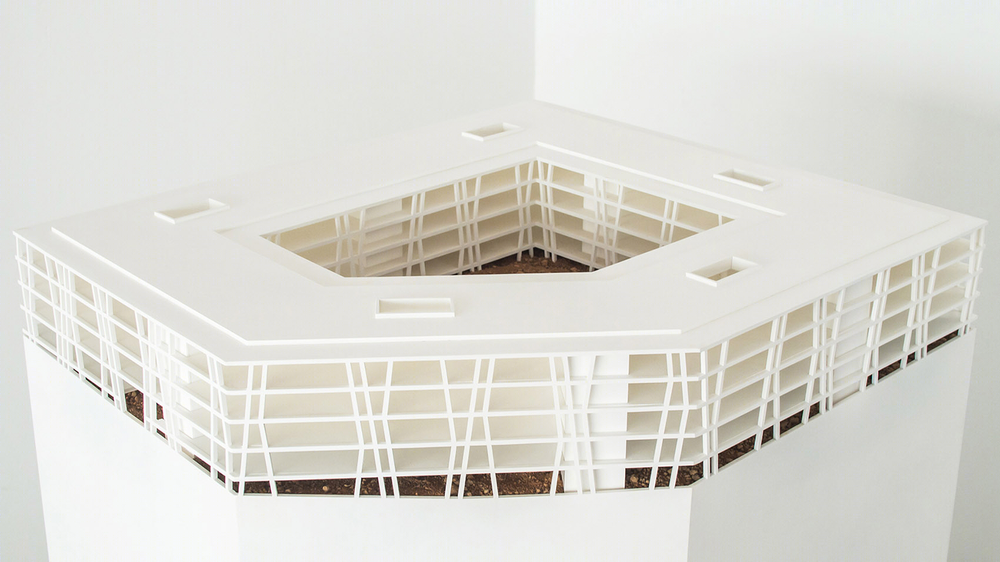
▼平面图,plan

▼剖面图,section

Project: Concrete Lace Location: Hanoi, Vietnam Client: FPT Software Type: Private Commission Program: 20’000 m2 of office space Year: 2014 – 2016 Photographer: Patrick Bingham-Hall, Nguyen Duy Thanh & Le Hai Anh


